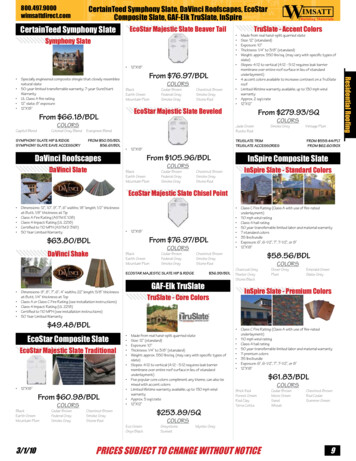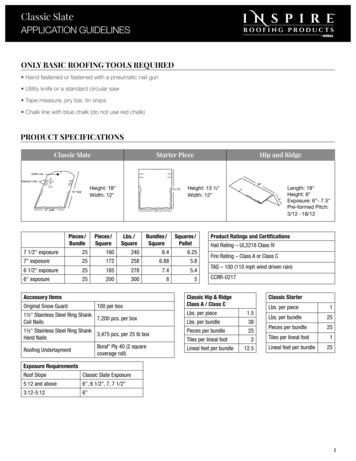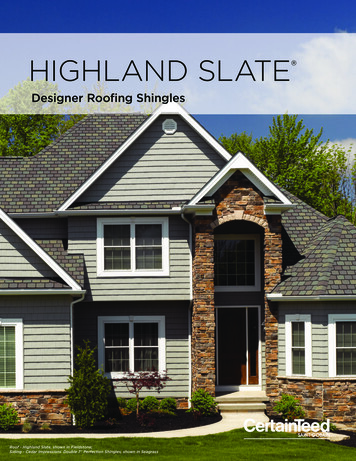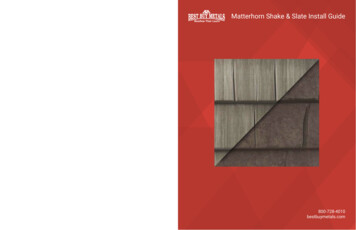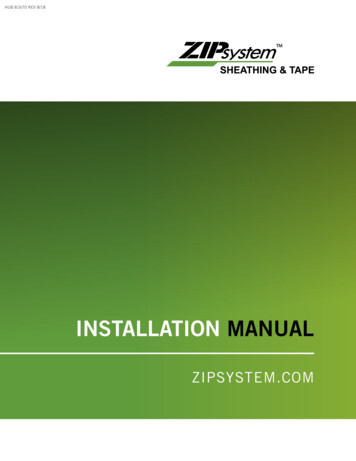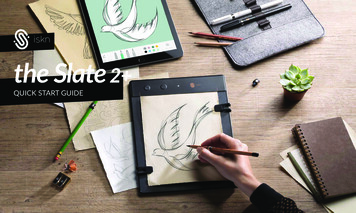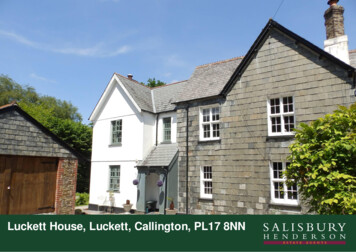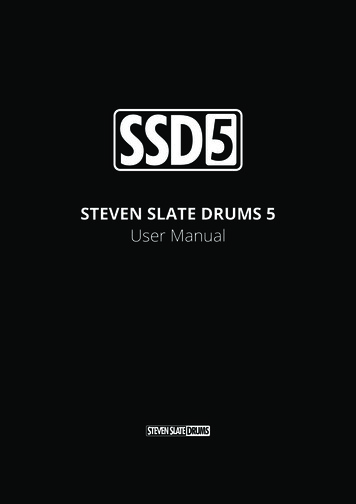
Transcription
STEVEN SLATE DRUMS 5User Manual
User ngs5Construct Kit7Edit Instrument9Articulations11Dynamics11Microphone Section12ADSR13Mixer14Mixer Routing15Mapping17Grooves191stevenslatedrums.com
User ManualINTRODUCTIONSteven Slate Drums 5, or SSD5 is the next generation virtual drum plugin. It consists of adrum sampler and an instrument library.SSD5’s library comes with over 400 instruments in it, ranging from acoustic drums, topercussion, to electronic drum samples.Drum instruments are made up of 24 bit multi-mic WAV samples packed into our proprietary format with revolutionary lossless compression. This allows us to decrease the size ofthe instruments up to 3 times by saving hard disk space and RAM.SSD5 drum instruments have up to 24 velocity layers, which are drum hits sampled fromsoftest to hardest. SSD5 also comes with 12 alterations or round-robin hits which aremultiple hits within one velocity layer. The purpose of alternating hits is to make thesamples sound more realistic and natural. Typically with alternating hits, it’s impossible todetect sampled drums because the hits are not repeating. This will eliminate mostcommon complaint from using sampled drum instruments, the machine gun effect.In addition to our very detailed drum samples, the SSD5 Sampler is the only sampler on themarket with intelligent playback. This is physically modelled after real life acoustic drumsand drumming. While all other virtual drums use the classic approach to sample playbackcalled the “polyphonic playback,” which is just samples playing independently and stackingup until they reach polyphony voice limit, the SSD5 sampler models the behavior of a realdrum kit. Samples in SSD5 interact with each other and do not stack up like they would inpolyphonic playback. Every new hit depends on all the previous hits and on what kit piecesare playing at the moment.Depending on type of drum and library, the SSD5 instruments may have a different amountof mics in each instrument. For example, the newest Deluxe 2 library has up to two directmics per shell.This means the kick would have “Kick In” and “Kick Out” samples, and the Snare would have“Snare Top” and “Snare Bottom” samples, etc.2stevenslatedrums.com
User ManualThe SSD5 instrument library has different categories including instruments from previousversions of Steven Slate Drums, so users can always have access to their favorite sounds,even from first versions of Steven Slate Drums:SSD5 Deluxe 2: The newest instruments recorded for SSD5. These are the mostdetailed instruments with more velocities, alternating hits and articulations. A widearray of improvements have been implemented from previous versions of Steven SlateDrums. The samples are unprocessed with the exception of slight EQ and compression. All the overheads are unprocessed (except for a mellow high-pass). The roommics are only processed with light and subtle compression as well as a gentle mid cut,which allows them to sit much better in the mix.SSD5 Deluxe 1: The sample pack recorded for SSD4. They were the first Steven Slatesamples with almost no processing. The only processing is a small mid cut in some ofthe samples.SSD5 Classic Vol.1 and Vol.2: The old Steven Slate samples. Unlike newer samples,these don’t contain overhead mics. They contain one mono direct mic and one stereoroom mic. The samples are fairly heavily processed, but still with a lot of room tosculpt and shape your own sound out of them.SSD5 Classic Signature: Older Steven Slate drum samples with similar characteristicsas Vol.1 and Vol.2, but the drum tones are significant as they are modelled afterfamous drum sounds heard on various hit records.SSD5 Electronic: A set of SSD5 samples that consist of electronic drum sounds.3stevenslatedrums.com
User ManualSAMPLERThe SSD5 Sampler is the simple, powerful, and effective sample player for the SSD5 library.It’s very easy to operate this plugin and achieve your desired results. The sampler has twoglobal sections (Pic 1):1Navigation: Switch sections as well as do some basic operations. There is also adisplay for memory usage and Snare Mode2Functional Controls and Settings: For some sections the right panel will be split intoa top and bottom section, where top may have browser, or functional controls forinstruments mics and articulations, and bottom panel, which displays virtual drum kit,or mixer depending on section opened at the moment.Pic 1 (SSD5 Sampler)4stevenslatedrums.com
User ManualOperationDrag and Drop to load instruments into pads and virtual drums and to re-map indrop MIDI grooves to DAW from the groove player.Double-Click button to load kit preset, or to reset a control (such as a knob, or fader)Right-Click on virtual drums to remove instrument. Left-Click (ctrl/cmd left-click) on virtual instrument to remove instrument. Additionally for knob/fader fine-tune as well as selecting groups of faders in Mixer. It canalso can be used on ADSR screen to copy mics settings. Left-Click (alt left-click) to reset controls such as knobs or faders. It can also canbe used on ADSR screen to paste mics settings.SettingsFirst, you’ll need to select your Base-Directory. You’ll only need License Files for expansionpacks. (see Pic 02)Pic 2 (Settings)5stevenslatedrums.com
User Manual1Base Directory: Navigate to the folder that contains your SSD5 Library. Once selected, the samples will be available in the Construct Kit area.2Version Number: Displays the version of sampler.3View: Cells View and Kit View. The Cells View displays virtual drums as pads, inwhich you can load instruments. The Kit View show a virtual drum kit with Kick,Snare, (4) Toms, Hi-Hat, Splash, (2) Crashes, Ride and a China. On the left and rightsides of the Kit View there are 20 additional small pads to load instruments in.4License Files: SSD5 Sampler houses all of our expansion packs. Most of our packscome with personalized license files. After installing an expansion pack, add thelicense to the Sampler in order to use this pack. Press “Set License File” button to adda license files to SSD5. Press Check Licenses Availability to check the license files.5Drumkit Detail: This section allows for determining how much alterations, or roundrobin hits, will be utilized into RAM for each instrument. The purpose of this setting isto save memory if needed.6Resampling Quality: Sets the quality of resampling while working in a sample rateother than 44.1 kHz. “Maximum” is recommended if CPU power is not an issue.7Disk Streaming: Allows the sampler to read the drum instruments from the harddrive, instead of fully loading them into memory. The buffer size determines theamount of each instrument that is cached into memory. The disk streaming featureallows for saving memory, but is not recommended unless memory space is at apremium. Even with fast hard drive speeds, it is possible to have some sound dropouts due to high hard drive load.8Respect OS Display Scaling: Determines the behavior of the sampler interface, orGUI with no non-standard DPIs, or graphics scale, including systems with a Retina set.9Master Volume: Determines the overall sampler’s output volume.Ambient Mic Volume: Determines the amount of ambient layering present in theaudition path. Usually ambient mics will be much lower in volume than direct mics,but inside the instrument the mics are relatively similar in volume. Due to this, whileauditioning, they may have sounded strange. Lowering their volume in this sectionlets you find the comfortable balance between direct mics and ambient mics foraudition instruments in browser.Let’s move on to working with drum sounds 6stevenslatedrums.com
User ManualConstruct KitOn the left panel select the Construct Kit button. This section contains a browser on topand virtual drums graphic below (Pic 3).Pic 3 (Construct Kit)1Clear Kit and Save Kit: Clear Kit allows you remove all instruments and samplesloaded at the moment, resets the mixer, and will start you from a default setting.Save Kit allows you save your kit preset and use it in the future.2Instruments and Samples: They let you switch between the instruments loadingscreen and the user samples loading screen.3Instruments and Kits: Provides the option to switch between two browsers on thetop panel.4Refresh: This will refresh your library. If you download a new expansion pack,you’ll drop it into your base directory, and refresh to update your sample library.5Audition: When browsing instruments, you’re able to hear them before loadingthem into your kit by enabling the Audition mode.7stevenslatedrums.com
User ManualNOTE: Instruments such as Hi-Hats, and Rides do take some time to audition; around 0.5sdepending on disk speedLoading Drum Instruments: Drag the instrument from the browser and drop it onto thedesired virtual drum, or side sample slot. SSD5 comes with a vast array of drum samples,and by utilizing blending and layering, you have an infinite number of possibilities. Forexample blending two different Snares will create the equivalent of a new Snare sound. It’svery easy to layer drums with SSD5 even if they are from different expansion packs.Preset Kits: SSD5 includes a wide variety of pre-mixed, fully assembled, diverse preset kits.Kits allow you to double-click on a kit preset in order to load an entire drum kit. You canload kit presets one over another, no need to clear kit before loading the next one.Pic 04 (Kit Browser)SSD5 has also the option to import 16 bit & 24 bit 44.1 kHz WAV files. They are locatedinside the SSD5Library folder entitled “OneShotSamplesData.” Your SSD5 library alreadycomes with a few WAVs as examples. You can link different folders with your ownOne-Shots as well. The One-Shot samples are available by selecting “Samples” on the lefthand side menu.Pic 5 (Samples Browser)8stevenslatedrums.com
User ManualEdit InstrumentAfter you’ve assembled your virtual drum kit or preset, the next section you will want to usis the Edit Instrument area. You can fine tune some of the characteristics of the instruments such as velocity curves, articulation volume, mic volume, pan, etc. (Pic 6)Pic 6 (Edit Instrument)To edit an instrument, select the instrument below. After it’s done, you will see the name ofthe instrument in the left corner of the top panel as well as picture of the drum just belowthe name (Pic 7).9stevenslatedrums.com
User ManualPic 7 (Instrument Adjustments)Instrument Volume: Adjusts the volume of the entire instrument.Instrument Tune: Allows for the changing of the pitch of the instrument.Instrument Phase: Flips the phase of the whole instrument. This gives you more flexibilitywhen setting up phase.NOTE: Usually in similar plugins, users only have the possibility of flipping phase only on selectmicrophones, such as direct microphones, OH or Room. Additionally, SSD5 allows you to flip theglobal phase of the entire instrument, which is a feature that is missing from some of the othersamplers on the current market. In other popular samplers, flipping the phase on rooms andoverheads flips the phase on the whole channel, which forces the phase of the rooms andoverheads to flip on all instruments.10stevenslatedrums.com
User ManualArticulationsPic 8 (Articulations)Articulation Name: Displays the name of the current articulation. Additionally, by clickingon a name you can audition this articulation. You’re also available to audition the articulation at different velocities depending on where the name bar is clicked. The articulation issofter with a click on the left side of the bar, and harder to the right.Articulation Volume: Adjusts the volume for each articulation separately. This option letsyou fine tune the volume of any articulation included in instrument such as Hi-Hat pedal, orSnare Sidestick.DynamicsDynamics: Allows you adjust the volume spread of softhits compared to hard hits. It allows you quickly controlthe volume intensity of soft hits samples without adjusting MIDI velocity values. This feature allows flexibilityduring mixing, and allows you to quickly change thedynamic perception.Velocity Curve: This will shift velocity inside the pluginafter receiving data from your MIDI track. It aids in adjusting the velocities being triggered. For example, a “Velocity”Pic 9 (Dynamics)value of 50 provides exact velocities for 0-127 (64 64 and112 112). With a “Velocity” value of 80, the MIDI velocity64 on your MIDI track will be 85 in SSD5 and will triggerthe articulation intensity globally across the instrument.11stevenslatedrums.com
User ManualRange Max/Range Min: Determines the hardest and softest allowed velocity in the instrument that can be triggered. This can help you adjust the character of instrument for thespecific genre, or style.For example - when searching for a gentle vintage sound, set “Range Max” to 105. Thisforces the instrument to scale back louder hits above 105 to a maximum velocity of 105(127 105) . The same applies in the opposite direction if you set the “Range Min” to 35, yourintensity will be scaled a bit higher (0 35). Limiting the velocity range will not decreasedynamic range. The samples’ volume will be scaled accordingly, preserving the entiredynamic range of the mic.Microphone SectionPic 10 (Microphones)1On/Off: Enables or disables the individual articulation.2Name: Name of articulation inside the instrument. Clicking with highlight the articulation in brown.3Routing: You can adjust the routing of individual mics. This will open up the possibility of sending various instruments into various Slate Rooms or seperate outputs toadjust individually throughout your daw via Multi-Out (see Mixer Routing).4Volume: Corresponds to individual mic.5Pan: Adjusts the proportion between the left and right channel in the stereo field.12stevenslatedrums.com
User ManualADSRADSR (Attack, Decay, Sustain, Release) The SSD5 Sampler is the only sampler onthe market currently, that allows you toset the curve shape for each phase of thecurve. It allows you shape the sound of theinstrument in thousands of different ways.This opening endless possibilities forsound design.Pic 11 (ADSR)1On/Off: Enables the ADSR envelope.2Link: Links all the mics. ADSR will be same for all mics within the instrument.3Attack: Controls the Attack time on instrument curve.4Decay: Controls the Decay time that shapes the signal before reaching Sustain phase.Combining with Decay Curve setting lets you shape sounds similarly to transientprocessors, or compressors.5Sustain: Sets the time of the sustain.6Release: Controls the time of release; similar to using a fade out.7Attack Curve: Controls the shape of the attack opening a wide array of possibilities.8Decay Curve: Controls the shape of the decay; similar to dynamic processors.9Sustain Volume: Controls the volume in sustain phase10 Release Curve: Controls the shape of instrument release; similar to a fade out curve.Note: It is also possible to copy and paste the ADSR settings from one instrument to another. Tocopy, hold (PC-Control/Win) and left click on the curve display. Then hold (PC-ALT) and leftclick on curve display. This manipulation copies and pastes the curve of all the mics in theoriginal instrument, instead of just (1) microphone.13stevenslatedrums.com
User ManualMixerPic 12 (Mixer)The mixer section allows you to easily mix and route your microphones into the DAW.Select the desired mixer strip to view and edit the corresponding instrument. The topMixer section is a mirror of “Edit Instrument”, allowing editing for the instruments parameters.To select multiple mixer strips, select the strip headers while holding Command (Mac) or Control (PC).The mix strips contain standard channel strip parameters that are seen in all popularDAWs: Mic Name - Library Name - Volume Fader - Pan - Solo - Mute - PhaseRouting Destination: Allows you to route the instrument signal to multiple output sources. This utilizes Multi-Out feature, which allows routing after SSD5 in your DAW. Multi-Outallows for external DAW processing with either Slate Digital plugins or any other 3rd partyplugin!14stevenslatedrums.com
User ManualMixer Color CodingPic 13 (Color Coding)Blue:Direct or Close MicsBronze:One-Shot samplesViolet:Ambient MicsPink:Aux ChannelsMixer RoutingRouting can be achieved manually, via selecting outputs for each mic, or automatically viaRouting Presets. Using Multi-Out grants flexibility and unlocks the possibility that allows forthe most powerful and detailed drum sound.SSD5 has 16 stereo and 16 mono for a total of 48 total routing channels. The track count isdependent on your DAW’s limitations. For example, Logic only allows for 16 individualoutputs.Manual Routing: Select on the output name on the bottom of each mixer strip, then selectthe desired output.Routing Presets: Select the current routing preset, and choose the desired preset. (Pic 14)15stevenslatedrums.com
User ManualPic 14 (Routing Presets)In the Routing Preset menu, select a desired preset, or choose Manage Presets. This is theoption that user routing presets can be loaded and saved from.SSD5 Routing is not just the ability to route mics into the DAW, but also route them insidethe SSD5. For example: If you’re using primarily Deluxe 2 instruments loaded, except for thesnare, you’ll have Room A and B available, while Classic and Deluxe 1 instruments have justone room mic. If you have a snare sound consisting of Deluxe 1 and Classic samples, youcan route the Deluxe 1 room into Room A and Classic room into Room B using Mics panel.SSD5 now comes with an SLR channel. The SLR channel is the bleed from the kick and tomsinto the snare bottom mic. It can be routed into the same output as your direct snare mic, inorder to make the bleed characteristic sound just like a real acoustic drums recording.16stevenslatedrums.com
User ManualMappingPic 15 (Mapping)Mapping has two subsections, or modes:Kit Mapping: Allows the ability to change the MIDI note associated with any SSD5InstrumentInput Converter: Modifies the “virtual note” that corresponds to the instrumentKit MappingKit Mapping allows you to map your drum kit to certain notes and CCs. When the InputConverter is untouched, the notes displayed in Kit Mapping are the actual notes, so theMIDI note numbers inside SSD5 are equal to note numbers in your DAW.Remapping articulations in Kit Mapping involves dragging and dropping the articulationonto desired note. The mapping you’re creating here will be saved with the kit preset aswell as the DAW project file.17stevenslatedrums.com
User ManualInput ConverterUsing this tool forces the notes inside SSD5 to become “virtual”. For example, the MIDI noteinside the sampler “D2” can be triggered with“C3” in your DAW’s pianoroll. This is done tokeep the drum kit mapping inside the SSD5 consistent, while also maintaining the ability tocreate and use different mapping presets inside SSD5.Pic 16 (Input Converter)Input Converter: To convert any note inside SSD5 to a different note inside your DAW,drag-and-drop the note in right column to the note in left column.In addition to remapping, there is the ability to duplicate the note. To do this, hold the Command (Mac) or Control (PC) key and drag-and-drop the note. To remove duplicatednotes, drag them to their original note.Bottom Mapping Section:Factory Reset: Resets input converter.Set as Default: This sets the current preset as default.Save Preset: Save the current mapping preset.Load Preset: Loads a mapping preset.18stevenslatedrums.com
User ManualGroovesPic 17 (Grooves)The Grooves section of SSD5 will assist you in creating the perfect drum track.The core library has 5 styles to choose from. There are even more “songs” inside each style.The “song” is a collection of grooves played with a similar feel and broken down to sectionssuch as Intro, Verse, Chorus, etc.Playback sectionAutoplay: Plays back the groovewhen selectedPlayStopsLoop: Loops the current groove1/2x: Toggles playback at half speed1x: Toggles playback at normal speed2x: Toggles playback at double speedDynamics: Adjusts the dynamics ofthe selected grooveDrag-and-drop the groove to export the MIDI region directly to your MIDI track inside your DAWNote: The Speed and Dynamics modifiers will be applied to the MIDI velocities when you dragthem into a MIDI Track in your DAW.19stevenslatedrums.com
Operation Drag and Drop to load instruments into pads and virtual drums and to re-map in drop MIDI grooves to DAW from the groove player. Double-Click button to load kit preset, or to reset a control (such as a knob, or fader) Right-Click on virtual drums to remove instrument. Left-Click (ctrl/cmd left-click) on virtual instrument to remove instrument.

